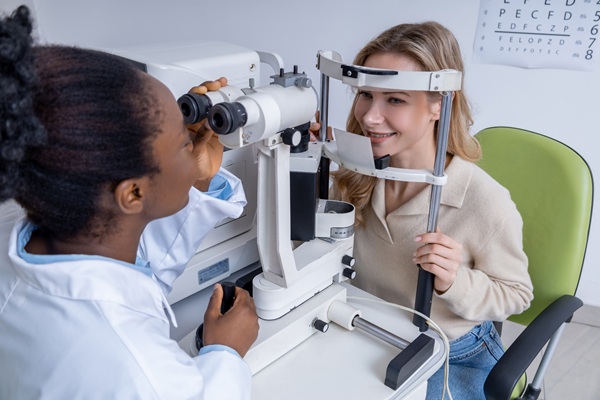Effective Keratoconus Treatment Options: Your Guide to Clear Vision

Skewed or blurry vision, sensitivity to light, and eye swelling can result from various factors, but sometimes it results from a thin, irregular-shaped corneus. Keratoconus treatment addresses issues or damage caused to this portion of the eye, but it does so through various means and depends on the stage of the condition.
An Overview of Keratoconus Treatments
Keratoconus stages explained
Before jumping into treatment options, it is important to know the various stages of the keratoconus, as this will always determine the treatment the optometrist employs. Put plainly, keratoconus means the cornea, the clear, dome part of the eye, becomes too thin and bulges into a cone shape. The new shape causes many vision and function problems, which the National Library of Medicine separates into:
- Normal. The eye looks normal, but the patient requires an eyeglass or contact prescription
- Suspect. Usually, the patient needs frequent eyeglass or contact prescription changes
- Mild. Vision in one eye is becoming blurred at night, or when looking at objects near or far, and swelling or inflammation may be present
- Severe. The cornea has become scarred or is extremely thin
Moreover, it is good to know that keratoconus can be genetic or a result of the patient's own doing. Patients with a parent or a grandparent with the condition, no matter the severity, are more likely to develop it as well. Johns Hopkins Medicine also believes it can develop in babies in the womb or during birth or be caused by general aging. Alternatively, keratoconus can develop due to patients constantly rubbing their eyes.
Keratoconus treatments
Corneal collagen cross-linking (CXL)
A keratoconus treatment for the condition's early stages is corneal collagen cross-linking or CXL. The procedure is simple, involving the optometrist using riboflavin eye drops and an ultraviolet light. The process aims to stiffen and stabilize the cornea, which, in turn, prevents further shape changes.
Corneal transplantation
If scarring is present or the cornea is extremely thin, the optometrist will introduce a corneal transplant or keratoplasty. This keratoconus treatment involves replacing all or the most damaged parts of the cornea with healthy donor tissue.
Intracorneal ring segments
Intracorneal ring segments are typically incorporated as part of a keratoconus treatment plan, with contact lenses taking the other part. Intracorneal ring segments involve flattening the cornea for better quality vision so the contact lenses can fit better. It requires inserting small synthetic ring segments and, if necessary, performing alongside CXL.
Specialized contact lenses
For the early stages of keratoconus, the optometrist will likely incorporate eyeglasses with a specialized prescription to curtail or stop the progression. However, for more advanced stages, they will introduce specialized contact lenses. Hard contact lenses, piggyback lenses, hybrid lenses, and sclera lenses are the most common types the optometrist will prescribe, each catering to the different shapes of the eye and severity of keratoconus.
See clearly once again
Keratoconus is a condition that does not go away on its own. It requires special treatments or appliances, which we can provide. If you have been diagnosed or believe you have this condition, contact us today. Our team can craft a keratoconus treatment plan to help you regain vision clarity.
Request an appointment here: https://brighteyesny.com or call Bright Eyes Optometry at (914) 730-9574 for an appointment in our New Rochelle office.
Check out what others are saying about our services on Yelp: Keratoconus Treatment in New Rochelle, NY.
Recent Posts
Prescription glasses are an important part of clear vision and eye health. However, if you break or damage your glasses, it is important to act quickly to avoid further problems and restore your sight. Fortunately, taking care of damaged prescription glasses as soon as possible can save you time, money, and discomfort.The first step after…
Dry eye may start with mild irritation, but over time, it can begin to interfere with focus, comfort, and even quality of life. An optometrist can help when this condition becomes more than just a temporary annoyance. There are many potential causes of dry eye, including hormonal changes and seasonal allergies. With tools that reveal…
Keratoconus treatment delivers the best results when symptoms emerge early and an optometrist confirms the diagnosis. Keratoconus thins the cornea and alters its curve, causing blur, ghosting, and light sensitivity. Early care slows progression and restores functional vision. An optometrist uses specialized imaging and targeted therapies to stabilize the cornea and improve clarity. Knowing when…
Emergency eye care is essential for preserving vision and preventing long-term damage when unexpected injuries or symptoms occur. As an optometrist, providing immediate attention to urgent eye conditions can significantly impact patient outcomes. Understanding when to seek emergency treatment and what steps to take can help safeguard ocular health.Certain symptoms and injuries require immediate professional…


